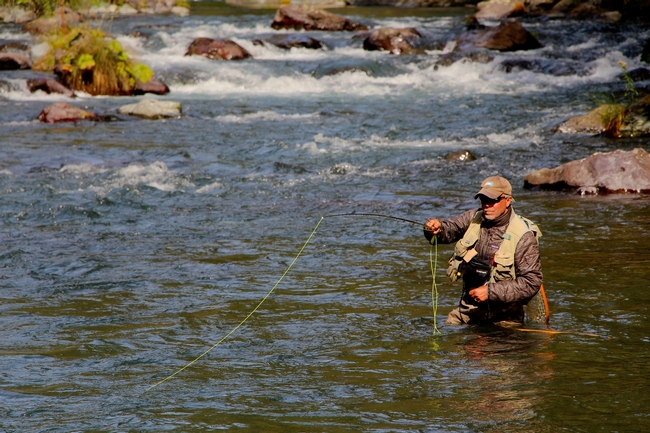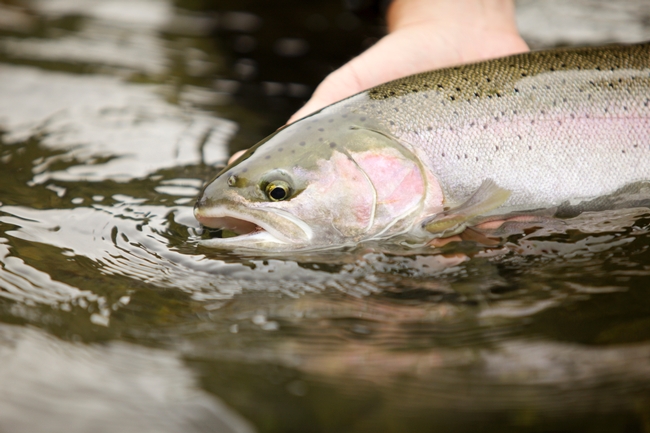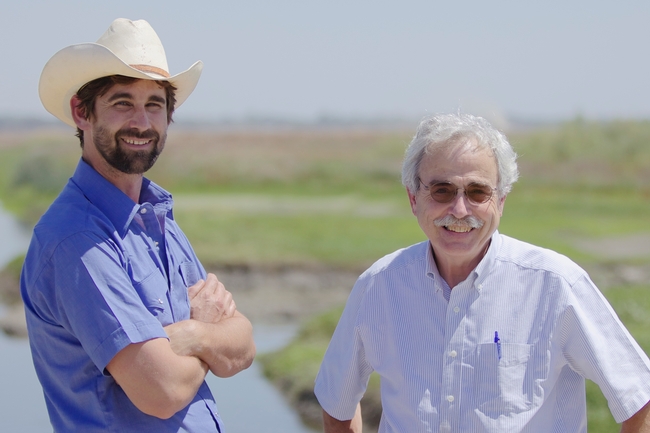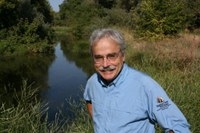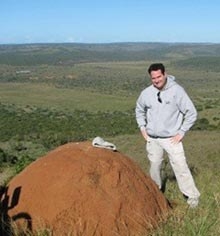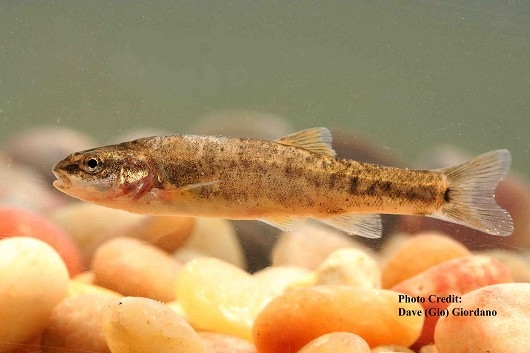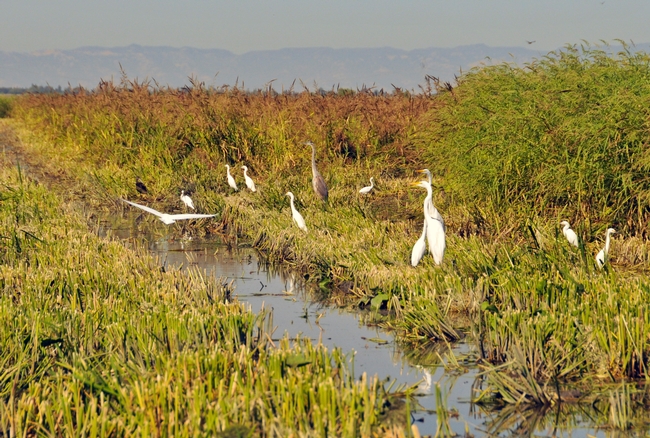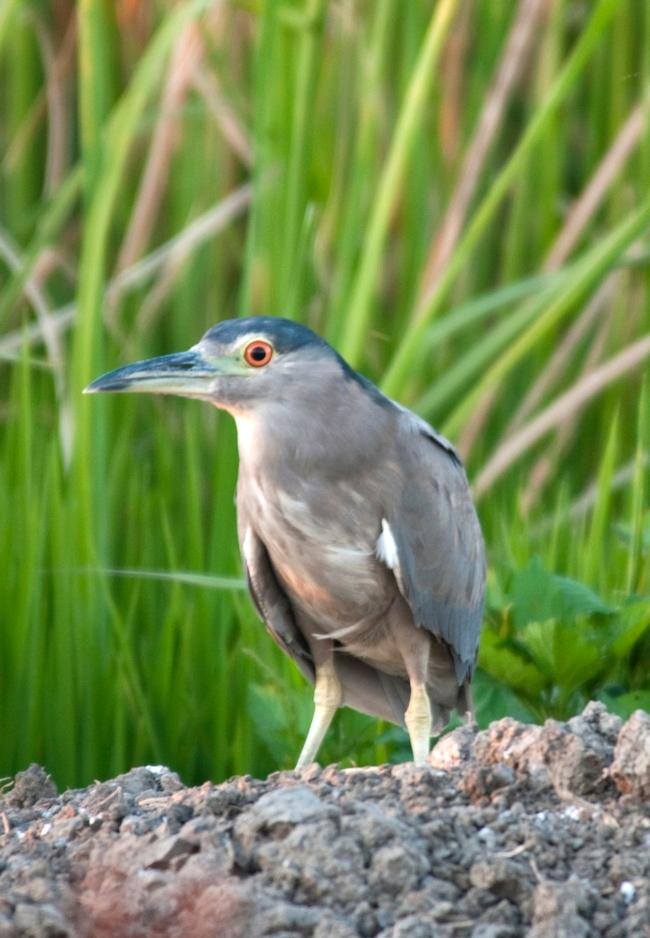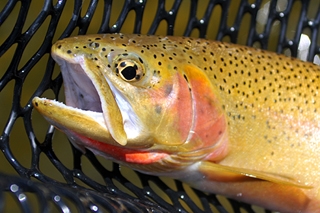Posts Tagged: Moyle
Conservation organization California Trout helps establish endowed chair at UC Davis
California once teemed with millions of native salmon, trout and steelhead. The state has 31 distinct types of these iconic, majestic fish. But decades of degradation to aquatic habitat has depleted their numbers in many areas of the state. According to a report by UC Davis fisheries professor Peter Moyle and colleagues, 20 of these fish species are in danger of extinction within the next century. They are important species not just for the recreational or commercial benefits they afford, but also because they are a direct reflection of the health of the environment.
“Large self-sustaining populations of native salmon and trout are found where streams are in reasonably good condition,” Moyle wrote in his 2008 report, “SOS: California's Native Fish Crisis.” This report was commissioned by the conservation organization California Trout (CalTrout), which exists to support conservation science, education, and advocacy efforts to protect California's water resources and fisheries.
Moyle, whose academic home is the Department of Wildlife, Fish and Conservation Biology at UC Davis, is no stranger to CalTrout. He is the foremost authority on California's native freshwater and anadromous (sea-run) fishes and has been a leader in research and conservation efforts. His research has provided the core science essential to statewide conservation planning for freshwater and estuarine native fishes, especially salmon and trout. Graduate students who studied with Moyle now occupy many top-level fish ecologist and management positions in state and federal agencies, as well as key nonprofits like CalTrout.
In May of this year CalTrout and UC Davis announced the formal creation of the Peter B. Moyle and California Trout Endowed Chair in Cold Water Fishes. The endowment will provide crucial support for the chair holder's scholarly activities, teaching, and public service involving cold water fish and aquatic ecosystems. He or she will teach department courses, mentor graduate students, conduct research and outreach, and provide leadership in the conservation of cold water fishes and their ecosystems. The university recognizes that salmon, trout, and steelhead are the major drivers of many conservation efforts and will have the highest priority in the chair's program.
Most of the contributors to the endowment are CalTrout board members such as Nick Graves. He and his wife, Mary, explored many trails and trout waters in the Sierra Nevada over the years and have enjoyed larger rivers flowing from the Trinity Alps, Mt. Shasta, and the Siskiyou Mountains. “The opportunity to create a scientific chair whose research targets California waters, in perpetuity, is a comforting thought,” Graves said.
“I have worked with the organization since its earliest days and have always admired the dedication of its members to aquatic conservation,” Moyle said. “I am biased, of course, but I think CalTrout has made a very smart investment in the future by creating an endowed chair.”
UC Davis scientists share perspectives on endangered species
You don't have to dig too deep into the scientific literature and popular media to find perspectives on threats posed to biodiversity in California and around the globe. Two UC Davis scientists in the Department of Wildlife, Fish and Conservation Biology have published fresh insights into endangered species in recent months.
Endangered Species Act sets a high standard
Peter Moyle, professor in the Department of Wildlife, Fish and Conservation Biology, is a renowned expert on California's native fish. He used the occasion of the 40th anniversary of the passage of the federal Endangered Species Act (ESA) in December 2013 to size up how the act influenced his own research and how some of California's aquatic biota have fared.
After passage of the ESA, Moyle and his graduate students initially searched for three species they suspected were in trouble: Modoc sucker, rough sculpin and bull trout. They found the sucker in trouble but easy to protect, the sculpin reasonably secure, and the bull trout near extinction in California. It has since vanished.
"As an untenured professor then, I thought it a bit risky to base a career on finding rare fish," Moyle wrote in an opinion piece published in The Sacramento Bee. “So I also undertook a study of Delta and longfin smelt, which at the time were two of the most abundant fish in the Sacramento–San Joaquin Delta.”
Moyle began a monthly sampling program to keep track of smelt populations and other fish in the Suisun Marsh. A few years later smelt counts dropped dramatically. The data eventually led to the U.S. Fish and Wildlife Service listing the Delta smelt as a “threatened” species under the ESA.
His ongoing research has recorded a statewide decline of most native fishes. With other researchers, Moyle has just completed detailed accounts of the biology and status of more than 60 native fishes — all potential candidates for ESA listings. This study will soon be released by the California Department of Fish and Wildlife.
“Most of our recommendations for preventing extinctions call for more and better water for the fish, or at least for protecting existing water they depend on,” Moyle said. “Funny how it almost always comes down to fish needing water.
“The Endangered Species Act sets a high standard in this regard because it not only forbids extinction; it also mandates recovery of each species to a more sustainable state.”
Moyle's opinion piece can be viewed in its entirety here.
Human longevity an indicator of endangered species
Aaron Lotz is a postdoctoral scholar who has previously worked with other UC Davis scientists in the development of conservation and management plans for reptiles and amphibians in California. Recently he was involved in a study published last fall in the journal Ecology and Society on the social and ecological predictors of global invasions and extinctions.
The researchers analyzed data from 100 countries, representing 87 percent of the world's population. They examined 15 social and ecological variables, such as tourism, per capita gross domestic product, water stress and political stability. The study showed that as human life expectancy increases, so does the percentage of invasive and endangered birds and mammals.
“It's not a random pattern,” Lotz said. “Out of all this data, that one factor — human life expectancy — was the determining factor for endangered and invasive birds and mammals.”
New Zealand, the United States and the Philippines had among the highest percentages of endangered and invasive birds. The study has been reported in the Los Angeles Times and other news media. Read more about the study's findings in our news release here. The journal article can be viewed here.
Climate change threatens California native fish
The study, published online in May in the journal PLOS ONE, assessed how vulnerable each freshwater species is to climate change and estimated the likelihood that those species would become extinct in California within 100 years.
The researchers found that, of 121 native fish species, 82 percent are likely to be driven to extinction or very low numbers as climate change speeds the decline of already depleted populations. In contrast, only 19 percent of the 50 non-native fish species in the state face a similar risk of extinction.
“If present trends continue, much of the unique California fish fauna will disappear and be replaced by alien fishes, such as carp, largemouth bass, fathead minnows and green sunfish,” said Moyle, who has been documenting the biology and status of California fish for the past 40 years.
“Disappearing fish will include not only obscure species of minnows, suckers and pupfishes, but also coho salmon, most runs of steelhead trout and Chinook salmon, and Sacramento perch,” Moyle said.
Fish requiring cold water, such as salmon and trout, are particularly likely to go extinct, the study said. However, non-native fish species are expected to thrive, although some will lose their aquatic habitats during severe droughts and low-flow summer months.
The top 20 native California fish most likely to become extinct in California within 100 years as the result of climate change include (asterisks denote a species already listed as threatened or endangered):
- Klamath Mountains Province summer steelhead
- McCloud River redband trout
- Unarmored threespine stickleback*
- Shay Creek stickleback
- Delta smelt*
- Long Valley speckled dace
- Central Valley late fall Chinook salmon
- Kern River rainbow trout
- Shoshone pupfish
- Razorback sucker*
- Upper Klamath-Trinity spring Chinook salmon
- Southern steelhead*
- Clear Lake hitch
- Owens speckled dace
- Northern California coast summer steelhead
- Amargosa Canyon speckled dace
- Central coast coho salmon*
- Southern Oregon Northern California coast coho salmon*
- Modoc sucker*
- Pink salmon
The species are listed in order of vulnerability to extinction, with No. 1 being the most vulnerable.
Climate change and human-caused degradation of aquatic habitats is causing worldwide declines in freshwater fishes, especially in regions with arid or Mediterranean climates. These declines pose a major conservation challenge. However, there has been little research in the scientific literature related to the status of most fish species, particularly native ones of little economic value.
Moyle saw the need for a rapid and repeatable method to determine the climate change vulnerability of different species. He expects the method presented in the study to be useful for conservation planning.
“These fish are part of the endemic flora and fauna that makes California such a special place,” said Moyle. “As we lose these fishes, we lose their environments and are much poorer for it.”
Co-authors of the study were postdoctoral students Joseph Kiernan, Patrick Crain and Rebecca Quiñones of the Center for Watershed Sciences at UC Davis. Funding for the study was provided by the California Energy Commission.
Media coverage of the study includes:
USA Today: Climate change threatens 82% of native California fish
LA Times: California native fish could disappear with climate change
Flood protection, agriculture, fish and wildlife coexist in the Yolo Bypass
At times during the winter and early spring it looks like a vast inland sea between Sacramento and Davis. This is the Yolo Bypass, which shunts Sacramento River floodwater around the state capital during high flows. You drive over the bypass on a three-mile-long elevated stretch of Interstate 80 known as “the Causeway” (the Blecher-Freeman Memorial Causeway). The bypass is also the site of a lot of innovative fish and wildlife work.
From late fall through winter you can see thousands of ducks, geese and other waterfowl winging over the bypass’s flooded rice fields and the restored wetlands in the Vic Fazio Yolo Basin Wildlife Area.
The Central Valley of California is one of the nation’s most important migratory waterfowl corridors. The bypass provides essential winter habitat for these birds on their annual migration. The wildlife area is managed by the California Department of Fish and Wildlife. Learn more.A recent article in The Sacramento Bee featured a research project at a rice farming area in the upper reaches of the bypass that is examining how flooded fields could be used to fatten up young salmon during a crucial time in their life cycle. One part of the study is examining how soil type influences the production of insects — an important source of food for growing salmon. Carson Jeffres, a fish ecologist with the UC Davis Center for Watershed Sciences, is quoted in the story: "There are hundreds, if not thousands, of insects that are coming out of each 9-by-6-inch block of earth." You can also watch a YouTube video to hear UC Davis doctoral student Jacob Katz describe the project and read more about why fish find this floodplain so attractive in a previous Green Blog post by writer and photographer Trina Wood.
Part of the wildlife area is accessible by automobile — when it’s not flooded! Consider taking a tour of this remarkable and easily accessible area, or take binoculars to view the many birds. UC Davis fisheries professor Peter Moyle prepared a guide that will help you make the most of your visit.
Scientists examine California's vulnerability to climate change
The UC Davis research appears in a report, "Our Changing Climate," released today by the California Natural Resources Agency and the California Energy Commission. The report is the third assessment from the California Climate Change Center since 2006.
UC Davis scientists authored nine of the 35 studies contained in the report. The UC Davis work addresses climate change impacts on native fishes, agriculture, urban planning, water management and other issues:
* Peter Moyle, a wildlife, fish and conservation biology professor in the UC Davis Center for Watershed Sciences, studied the predicted effects of climate change on native fishes. His team found that most native fishes will suffer population declines, and some will likely go extinct. Fishes requiring cold water are particularly vulnerable.
Meanwhile, non-native fishes are expected to increase, although they will also experience habitat loss during severe droughts.
"California's unique native fishes are already in steep decline, and climate change is making the situation worse," Moyle said. "This is likely to increase the complexity of managing California's water supply. Preventing predictable extinctions is possible but will require planning now for increased water temperatures and more variable flows."
* James Thorne, a researcher in the Department of Environmental Science and Policy, helped create a model that simulates how rainfall interacts with the landscape. Thorne's research group looked at hydrologic data from the past and present to help predict what may happen in the future. That model was used for other studies in the report, such as those regarding fire and agriculture, allowing cross comparisons among the researchers' work.
Thorne also looked at six different policy options for urban growth, including smart-growth, infill and "business as usual" approaches.
"If we want the most lands preserved for a variety of different purposes -- agricultural and biodiversity protection, reduced fire threats -- the infill policy was best," Thorne said.
* Studies by Louise Jackson, UC Cooperative Extension specialist and professor in the Department of Land, Air and Water Resources at UC Davis, complemented Thorne's growth policy conclusion. Her group's case study focused on greenhouse gas emission mitigation and adaptation to climate change in Yolo County. They found that "channeling much or all future urban development into existing urban areas" will help preserve agricultural land and open space, reduce Yolo County's greenhouse gas emissions and enhance agricultural sustainability. Their research also found that farmers concerned about climate change were more likely to voluntarily adopt practices that would conserve water and reduce greenhouse gas emissions.
Jackson's group also developed an agricultural vulnerability index for California that identified four areas as especially vulnerable to the effects of climate change: the Sacramento-San Joaquin Delta; Salinas Valley; the corridor between Merced and Fresno; and the Imperial Valley.
* Jay Lund, director of the UC Davis Center for Watershed Sciences, examined climate change adaptations for managing water in the San Francisco Bay Area. His group's research suggests that Bay Area urban water demands can be largely met even under severe forms of climate change, but at a cost. The cost includes buying water from agricultural users, using more expensive alternatives such as water recycling and desalination, and some increased water scarcity. A shared connection of public water systems, or interties, recently completed for emergency response, greatly aids adaptation, the study reports.
* Joshua Viers, associate director of the Center for Watershed Sciences, co-authored a study analyzing "water year" classifications.
These indices determine whether a year is considered wet, dry or in-between, as well as how much water is allocated and who gets it.
"Unfortunately, the method to distinguish different water year types is indexed to historical climatic conditions and is intended to represent an equal chance for any given year," said Viers. "Our science suggests that future climatic conditions are not likely to represent this history, and thus water management agencies may need to reconsider these arbitrary indexing thresholds going forward to achieve a more equitable situation."
Viers also co-authored a study about climate change's impact on hydropower production in the Sierra Nevada. It found that an 11 F increase in air temperature would reduce hydropower in the area by about 10 percent, and that most reductions would occur in the northern Sierra Nevada. The central Sierra Nevada would adapt better to changes in runoff, while hydropower generation in the southern watershed would decrease.
Other institutions, including UC Berkeley, UC Santa Cruz, Stanford, the Scripps Institution of Oceanography, and Lawrence Berkeley National Laboratory researched climate change impacts on electricity consumption, sea level, wildfires and coastal flooding.
This assessment will provide a foundation for the state's 2012 Climate Adaptation Strategy, with completion expected in December 2012. Comprised of scientific studies from several academic institutions, the assessment is directed by the Governor's Office and intended to help state and local communities protect public health, grow the state's economy, ensure energy reliability and safeguard the environment.

